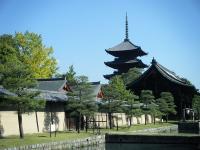Table of Contents
Buddha statue of Myoo(明王, Vidyā-rāja)
Unlike other Buddha statue, Myoo express rage on the face. Because the gods follow the order of Dainichi-nyorai to make people who deny Buddhism submit and believe in. In addition to the expression, they have dynamic power with a roaring fire and various weapons.
Sponsored Links
As the connection to Dainichi-nyorai, we can’t find the position of Myoo except in esoteric Buddhism. “Myo”(明) means mantra and the other”O”(王) represents king.
The five great wisdom kings
Fudo-myoo(不動明王, Acala naatha)
This “immovability”(fudo, 不動) god originates from Shiva of Hinduism, as with Juichimen-kannon. Shiva has the power of destruction and reproduction. Fudo-myoo inherited the power to give in people disturbing Buddhism. But after proceeding the way, the god always watch them without moving.
Japanese people have a friendly feeling with calling him “Ofudo-sama”. Not only Toji in Kyoto, there are a lot of the temples which worship the god including Takahata-Fudoson(高幡不動尊), Meguro-Fudoson(目黒不動尊) and Takiya-Fodoson(瀧谷不動尊). Though the god has fitted into the live of Japanese, he places the central position of the five great wisdom kings(五大明王) .
If you can look the Buddha statue closely, you would notice the uniqueness of the eyes. The right eye looks upward and the left downward. It is because the god looks out from the sky to the ground. The fangs also face in the same way. The right-hand holds a sword which represents the wisdom of Dainich-nyorai. And just like Fukukensaku-kannon, the left hand have a lasso(rope), to capture evil mind.
Gozanze-myoo(隆三世明王, Trailokyavijaya)

Receiving the order of Dainich-nyorai and Abin-nyorai, the god guards on the east side. The name means the one who submits three worlds(the past, present, and future) of three worldly passions(desire, anger, and ignorance).
While Dainichi-nyorai preached, Shiva and his wife Parvati didn’t follow the teaching of Buddhism. Then Gonzanze-myoo appeared and beat them. So the statues set them under the foot. Usually, it have four faces and eight arms with a fire halo and weapons.
Gundari-myoo(軍荼利明王 Kuṇḍalī)

The god takes on a role of the guardian for south. He follows Hosho-nyorai’s order to remove hardship. The name derives “a snake coiling up” or “the medicine of immortal”.
Generally, this kind of the Buddha statues have three eyes and eight arms. Two of them cross before the chest. And many of the images entangle around the arms or legs.
Daiitoku-myoo(大威徳明王, Yamāntaka)

The god receives the order from Amida-nyorai and the guard the west side. In Tibetan story, Monju-bosastu changed the figure into a buffalo to fight the demon with the face of the animal. He also has incredible power to overcome evil. For this reason, the name represents “who defeat the god of the hell”.
The images have three or six faces, arms and legs. They usually grab a sword, an ancient Chinese halberd, a ring, and a rod. And hands make original In-zo(印相, hand sign) .
Kongo Yasha-myoo(金剛夜叉明王, Vajra-yak a)

The last god of the five great wisdom kings follows the order of Fuku Joju-nyorai and protect north side. He also originated from the Indian god vajrayaksa. Due to its infrangible power, the name has the meaning of “diamond”.
The Buddha statues have usually three faces with five eyes and six arms. And the god holds a vajra(the Buddhist instruments to get rid of worldly desire), a vajrāṅkuśa(the holy hook to pick people for Buddhism), an arrow, a sword, a bell, a bow, and a ring.
Ususama-myoo(烏枢沙摩明王, Ucchuṣma)

In terms of Tendai sect, this god belongs to the the five great wisdom kings instead of Kongo Yasha-myoo. He was the fire god, Aguni, in Indian myth, so puts a halo with flames which burn away worldly desire all over the world.
Since fire has the power of cleaning impurity, Japanese people have worshiped for a long time the god as making a toilet and kitchen pure. He only has a single face. But when it come to arms, the Buddha statues take some types, two, four, six, and eight. Usually, the images have a sword, a rod, a lasso and a vajra.
Kujaku-myoo(孔雀明王, Mahāmayūrī‐vidyā‐rājñī)

Kujaku means peacock in Japanese. Because a peacock eats a poisonous snake, a symbol of worldly desire in ancient India, people deified as a god. Addition to that, the holy bird was believed to bring rain for them. So the god drives away desire and anguish, and give happiness.
As opposed to other Myoo, he express gentle face. Riding on a peacock, the four hands take a lotus flower, a pomegranate, and a peacock’s tail feather.
Sponsored Links
Daigensui-myoo(大元帥明王, Āṭavaka)

In ancient Indian myth, Āṭavaka lived in a forest and ate the weak or children as a devil. But the god became a believer of Buddhism and guardian for a nation with outstanding power.
The Buddha statues have one or six faces with rage expression and six arms. He equips a vajra and a sword. In Japan, the god’s image can’t be seen except Akishino-dera(秋篠寺) in Nara.
Aizen-myoo(愛染明王, Rāgarāja)
Though Buddhism considers that lust is one of the worldly desire which prevents people from achieving enlightenment, it also leads the mind seeking the awakeness. Aizen-myoo represents the concept and helps believers from the suffering of lust. Dainichi-nyorai or Kongozatta-bosatsu change the figure into the god.
The god of love shows anger on the face which have three eyes. The statues are usually painted in red. Interestingly, they often have a arrow and an bow like Cupid.
Sponsored Links
Back to the page of Buddha statue
Related posts:
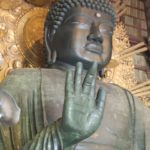 Nyorai(Tathāgata) for Japanese Buddha statue
Nyorai(Tathāgata) for Japanese Buddha statue
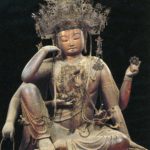 Bosatsu (Bodhisattva) of Japanese Buddha statue
Bosatsu (Bodhisattva) of Japanese Buddha statue
 The physical features of Buddha
The physical features of Buddha
 Japanese Kamakura scultupure, Spring Lecture of Mary Griggs Burke Center
Japanese Kamakura scultupure, Spring Lecture of Mary Griggs Burke Center
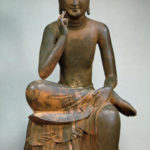 What does Buddha statue represent? And about the poses.(Japan)
What does Buddha statue represent? And about the poses.(Japan)
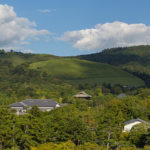 Japanese culture in Nara Period. The Tenpyo Culture
Japanese culture in Nara Period. The Tenpyo Culture


